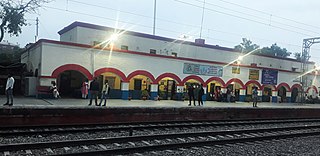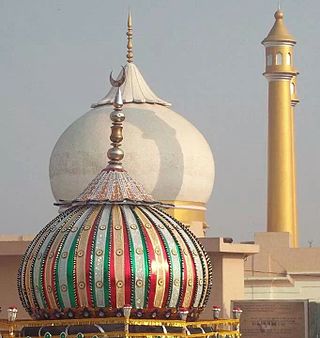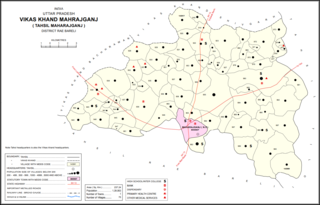Related Research Articles

Sayyid is an honorific title of Hasanids and Husaynids Muslims, recognized as descendants of the Islamic prophet Muhammad through his grandsons, Hasan ibn Ali and Husayn ibn Ali, sons of Muhammad's daughter Fatima and his cousin and son-in-law Ali.

Nawab Muhammad Amir Khan (1769–1834) was a military general in the service of Yashwantrao Holkar of the Maratha Empire and later became the first ruler of the princely state of Tonk. Amir Khan was a Hindustani Pathan and a North Indian Muslim. Born and bred in Sambhal, Amir Khan was the son of a Zamindar in Uttar Pradesh, Hayat Khan, while his grandfather Taleh Khan was a Pashtun from the Salarzai tribe of District Buner in modern-day Pakistan who had migrated to and acquired land in Rohilkhand.

Ghazipur is a city in the state of Uttar Pradesh, India. Ghazipur city is the administrative headquarters of the Ghazipur district, one of the four districts that form the Varanasi division of Uttar Pradesh. The city of Ghazipur also constitutes one of the seven distinct tehsils, or subdivisions, of the Ghazipur district.

Amroha is a city in the state of Uttar Pradesh in India. It is located north-west of Moradabad, near the Ganga River. It is the administrative headquarters of Amroha district.
Ballia is a city with a municipal board in the Indian state of Uttar Pradesh. The eastern boundary of the city lies at the junction of two major rivers, the Ganges and the Ghaghara.The city is situated 140 km (87 mi) east of Varanasi and about 380 km from the state capital Lucknow. It is home to a protected area, the Jai Prakash Narayan bird sanctuary. Ballia is around 4 km (2.5 mi) from Bihar.

Muzaffarnagar district is a district of Uttar Pradesh state in northern India. It is part of Saharanpur division. The city of Muzaffarnagar is the district headquarters. This district is the part of National Capital Region.

Bilgram is a town and a nagar palika parishad in Hardoi district in the state of Uttar Pradesh, India. It is located 16 miles (26 km) south of the city of Hardoi, on an elevated bluff that once formed the eastern bank of the Ganges. Important industries in Bilgram include ceramics and embroidery.
Muslim communities in South Asia have a system of social stratification arising from concepts other than "pure" and "impure", which are integral to the caste system in India. It developed as a result of relations among foreign conquerors, local upper-caste Hindus forced to convert to Islam and local lower-caste converts (ajlaf), as well as the continuation of the Indian caste system by converts. Non-ashrafs are backward-caste converts. The concept of "pasmanda" includes ajlaf and arzal Muslims; ajlaf status is defined by descent from converts to Islam and by pesha (profession). These terms are not part of the sociological vocabulary in regions such as Kashmir and Uttar Pradesh, and say little about the functioning of Muslim society.

Arabs in India are people with Arab origins who have over a long period of time, settled in the Indian subcontinent. There have been extensive trade and cultural links between India and the Arab world spanning several millennia. The west coast region of India, especially Malabar and Konkan coasts were active trading hubs, where Arab merchants frequently used to visit on their way to Sri Lanka and South East Asia. Over a span of several centuries, migrants from different Arabian nations immigrated to various regions and kingdoms of the Indian subcontinent as merchants, missionaries and through intermarriages.

Islam in Uttar Pradesh is the second largest religion in the state with 38,483,967 adherents in 2011, forming 19.26% of the total population. Muslims of Uttar Pradesh have also been referred to as Hindustani Musalman. They do not form a unified ethnic community, but are differentiated by sectarian and Baradari divisions, as well as by language and geography. Nevertheless, the community shares some unifying cultural factors. Uttar Pradesh has more Muslims than any Muslim-majority country in the world except Indonesia, Pakistan, Bangladesh, Nigeria, Egypt, Iran and Turkey.

Suhaldev or Suheldev was a legendary king from Shravasti. Persian Hagiography Mirat-i-Masudi, written in 17th century, popularly mentions him to have defeated and killed the Ghaznavid general Ghazi Saiyyad Salar Masud at Bahraich in 1034 CE. He was killed by Syed Ibrahim, a commander of Salar Masud.
Yusufpur and Mohammadabad is a Twin Town/Qasba in Mohammadabad Tahsil of the Ghazipur district of Uttar Pradesh, India.It belongs to Varanasi Division. Coordinates: 25°37′22″N 83°45′27″E It is located 21 km East of District head quarters Ghazipur and 347 km from the state capital, Lucknow. It borders the Ballia District, Mau District and Buxar District of Bihar. Yusufpur has a railway station which lies on the railway line linking Varanasi to Chhapra via Ghazipur and Ballia in the North Eastern Railway Zone. Yusufpur was founded by Qazi Ahmed Ansari in 1593.

The Oudh State was a Mughal subah, then an independent kingdom, and lastly a princely state in the Awadh region of North India until its annexation by the British in 1856. The name Oudh, now obsolete, was once the anglicized name of the state, also written historically as Oudhe.
Kanpur, India is the most cosmopolitan city in the state of Uttar Pradesh with vast number of ethnic groups and races. The city is mostly occupied by people from Uttar Pradesh. However, beside from Uttar Pradesh there are also people from other states and countries like-Punjabis, Irish, Bengalis, South Indians, Anglo Indian, Gujaratis, Iraqis, Portuguese, Gypsies, Parsis etc.

Thulendi is a village in Bachhrawan block of Rae Bareli district, Uttar Pradesh, India. It is located 6 km from Bachhrawan, the block headquarters, on an elevated plain with clayey soil. A historic village, Thulendi served as a pargana headquarters from the early 1400s until the late 1700s, and it has several old monuments including a fort built under the Jaunpur Sultanate and two large tanks othat are said to be even older. As of 2011, Thulendi's population was 6,616, in 1,195 households.

Hardoi is a village in Maharajganj block of Rae Bareli district, Uttar Pradesh, India. Located on the road from Maharajganj to Bachhrawan, Hardoi historically served as the seat of a pargana and has a now-ruined fort built in the early 1400s under the Jaunpur Sultanate. As of 2011, its population is 2,308, in 415 households.

Jalalpur Dhai is a village in Deenshah Gaura block of Rae Bareli district, Uttar Pradesh, India. It is located a short distance north of the Ganges, on the road from Dalmau to Mustafabad. As of 2011, it has a population of 5,520 people, in 966 households. It has one primary school and no healthcare facilities. Jalalpur Dhai hosts markets twice per week, on Wednesdays and Sundays, with cloth and vegetables being the main items traded.
Manzoor Alam Quraishi or M. A Quraishi was a member of the Indian Civil Service from the batch of 1941 and Uttar Pradesh Cadre soon after the Government of India Act 1935. He had a long and distinguishable career in civil service in India and was one of the few Muslim ICS members opting for India as opposed to Pakistan at the Partition of India 1947.
Zafrul Ahsan Lari was an ICS Administrator from the 1934 batch. His career in civil service is distinct. He worked during Partition of India 1947 at a senior level in which civil administration and government in Punjab were under stress due to the influx of refugees from the Indian side of Punjab, providing stability to the civil service run the newly born country, Pakistan.
Zahirul Hasnain Lari was a lawyer, a known Muslim League leader from Uttar Pradesh, India. He was a Pakistan movement activist and some acts of nationalism in his student life in India are noted.
References
- ↑ about district-history"Tehsil | District Ghazipur, Government of Uttar Pradesh | India,"
- ↑ Nevill, H. R., ed. (1909). Ghazipur: A Gazetteer, Being Volume XXIX of the District Gazetteers of the United Provinces of Agra and Oudh. Allahabad: Government Press. Retrieved 19 June 2023.
- ↑ Alhaj, Mohammad Hanif. Mardam Shumari.pdf-3.7.2022. Archived from the original on 20 October 2023. Retrieved 20 October 2023.
- ↑ Nohahra, Ghazipur "Sadat of Subcontinent India and Pakistan". Archived from the original on 7 January 2024. Retrieved 7 January 2024.
- 1 2 Jalil Ahmad Lari; Javed Ahmad Gauri; Tabrez Akhtar Lari. APNO KI TALASH FINAL Book Urdu. pp. 1–239. Retrieved 18 March 2023.
- ↑ Crooke, W. "The Tribes and Castes of the North-Western Provinces and Oudh".
- ↑ Zarina Ahmad (1962). "Muslim castes in Uttar Pradesh" (PDF). The Economic Weekly.
- ↑ Ghaus Ansari (1960). Muslim Caste in Uttar Pradesh: A Study of Culture Contact. Ethnographic and Folk Culture Society. OCLC 1104993.
- ↑ "iraqibiradripakistan".retrieved 20 Oct 2023